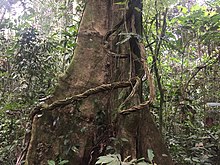Liana
Lianas are climbing plants with usually woody stems that root in the ground and climb up trees or other vertical structures. Lianas are not a natural phylogenetic relationship group, i.e. not a taxon, but they are a type of life form that has evolved convergently and in different forms in different taxa.
Several types can be distinguished among the lianas: Some climbing plants wind around the support in more or less numerous coils (winch or climbing plants). The direction of rotation, the sense of wind, is usually genetically determined depending on the kinship group.
- Climbing plants (e.g. peas, beans, ornamental squash, passion flowers, woodland vines and grapevines) usually form shoot- or leaf-borne climbing organs.
- Other lianas hold on with adhesive roots (root climbers, e.g. common ivy) or adhesive discs (e.g. maidenhair vines).
- Spreading climbers (e.g. brambles, climbing roses, burdock ragwort, winter jasmine, and stitch bindweed) brace their branches with the bearer plants by spreading laterally, with auxiliary organs such as climbing hairs, climbing hooks, or thorns preventing them from slipping back.
Lianas escape the lack of light near the ground without having to form a massive trunk. They are not parasites, so they do not extract nutrients or water from the carrier plant. However, they may be affected by light deprivation above, by water and nutrient competition in the root zone, or by the dead weight of the liana itself, especially if the carrier plants are already weakened by disease. Because of the abundance of such climbers in the rainforest, lianas may account for about half of the leaf area there. Many lianas in the tropical rainforest develop aerial roots. Water lianas can store half a glass of drinkable water in one meter.
Lianas are particularly numerous in the tropical rainforest. Native lianas in Central Europe include vines, hops, ivy, some species of blackberry, woodland vines and honeysuckle. On house fronts and pergolas, the blue-green lianas are horticulturally introduced and popular because of their splendid blossoms, although they are weighty.

Vine in the wildlife reserve Cuyabeno, Ecuador

Vine (Vitis vinifera) in its natural growth form as a liana
Search within the encyclopedia